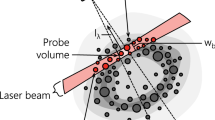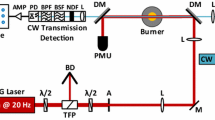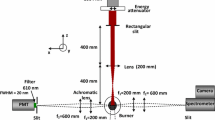Abstract
Time-resolved laser-induced incandescence (LII) signal of soot in an ethylene laminar diffusion flame was measured with varying laser pulse durations in the range 50–600 ns. This study presents original results since the majority of LII studies reported are based on 7–10-ns pulse duration. The LII signal from soot is a combination of heating and cooling processes of different time scales, and the influence of the pulse duration is therefore particularly relevant. The most striking finding is that when the pulse durations is longer than approximately 100 ns, the time-resolved LII signal reveals a rebound of the LII signal during its slow decaying part. This feature occurs preferably at high fluence and is unexpected as none of the physical and chemical processes known to control LII signal behaviour, and their models suggest such an effect. The phenomenon occurs with both top hat and near Gaussian temporal laser shapes. Inspection of the time-resolved emission spectra shows no indication of a laser-induced fluorescence effect, although gas-phase PAH generated during the laser heating of soot particles cannot be rejected. Other hypotheses are that the mechanism responsible for that behaviour is linked to a slow rate change of the soot morphological characteristics or to the generation of new particles during the long-duration laser excitation. Finally, experiments show that soot volume fraction measured by integrating the temporal LII signal is not affected by the pulse duration in any regions of the flame, implying that the LII method is applicable with long pulse duration lasers.








Similar content being viewed by others
References
R.L. Vander Wal, T.M. Ticich, A.B. Stephens, Appl. Phys. B 67, 115 (1998)
L.A. Melton, Appl. Opt. 23, 2201–2208 (1984)
H.A. Michelsen, J. Chem. Phys. 118, 7012–7045 (2003)
C. Schulz, B.F. Kock et al., Appl. Phys. B 83, 333–354 (2006)
I.M. Kennedy, Prog. Energ. Combust. Sci. 23(2), 95–132 (1997)
H.A. Michelsen, Appl. Phys. B 83, 443–448 (2006)
J.D. Black, Laser Applications to Chemical, Security and Environmental Analysis, OSA Technical Digest Series (CD) paper LWB5. Optical Society of America (2010)
J.P. Schwarz et al., J. Geophys. Res. 111, D16207 (2006). doi:10.1029/2006JD007076
M. Stephens, N. Turner, J. Sandberg, Appl. Opt. 42, 3726–3736 (2003)
P.E. Bengtsson, M. Alden, Appl. Phys. B 60(1), 51–59 (1995)
P.O. Witze, S. Hochgreb et al., Appl. Opt. 40(15), 2443–2452 (2001)
G.D. Yoder, P.K. Diwakar, D.W. Hahn, Appl. Opt. 44, 4211 (2005)
S. Will, S. Schraml, K. Bader, A. Leipertz, Appl. Opt. 37(24), 5647–5658 (1998)
H.A. Michelsen, A.V. Tivanski, M.K. Gilles et al., Appl. Opt. 46, 959–977 (2007)
H.A. Michelsen, P.O. Witze et al., Appl. Opt. 42(27), 5577–5590 (2003)
C.R. Shaddix, K.C. Smyth, Combust. Flame 107(4), 418–452 (1996)
Acknowledgments
This publication has been produced with support from the BIGCCS Centre, performed under the Norwegian research program Centres for Environment-friendly Energy Research (FME). The authors acknowledge the following partners for their contributions: Aker Solutions, ConocoPhillips, Gassco, Shell, Statoil, TOTAL, GDF SUEZ and the Research Council of Norway (193816/S60).
Author information
Authors and Affiliations
Corresponding author
Rights and permissions
About this article
Cite this article
Ditaranto, M., Meraner, C., Haugen, N.E.L. et al. Influence of long pulse duration on time-resolved laser-induced incandescence. Appl. Phys. B 112, 359–367 (2013). https://doi.org/10.1007/s00340-013-5546-7
Received:
Accepted:
Published:
Issue Date:
DOI: https://doi.org/10.1007/s00340-013-5546-7




